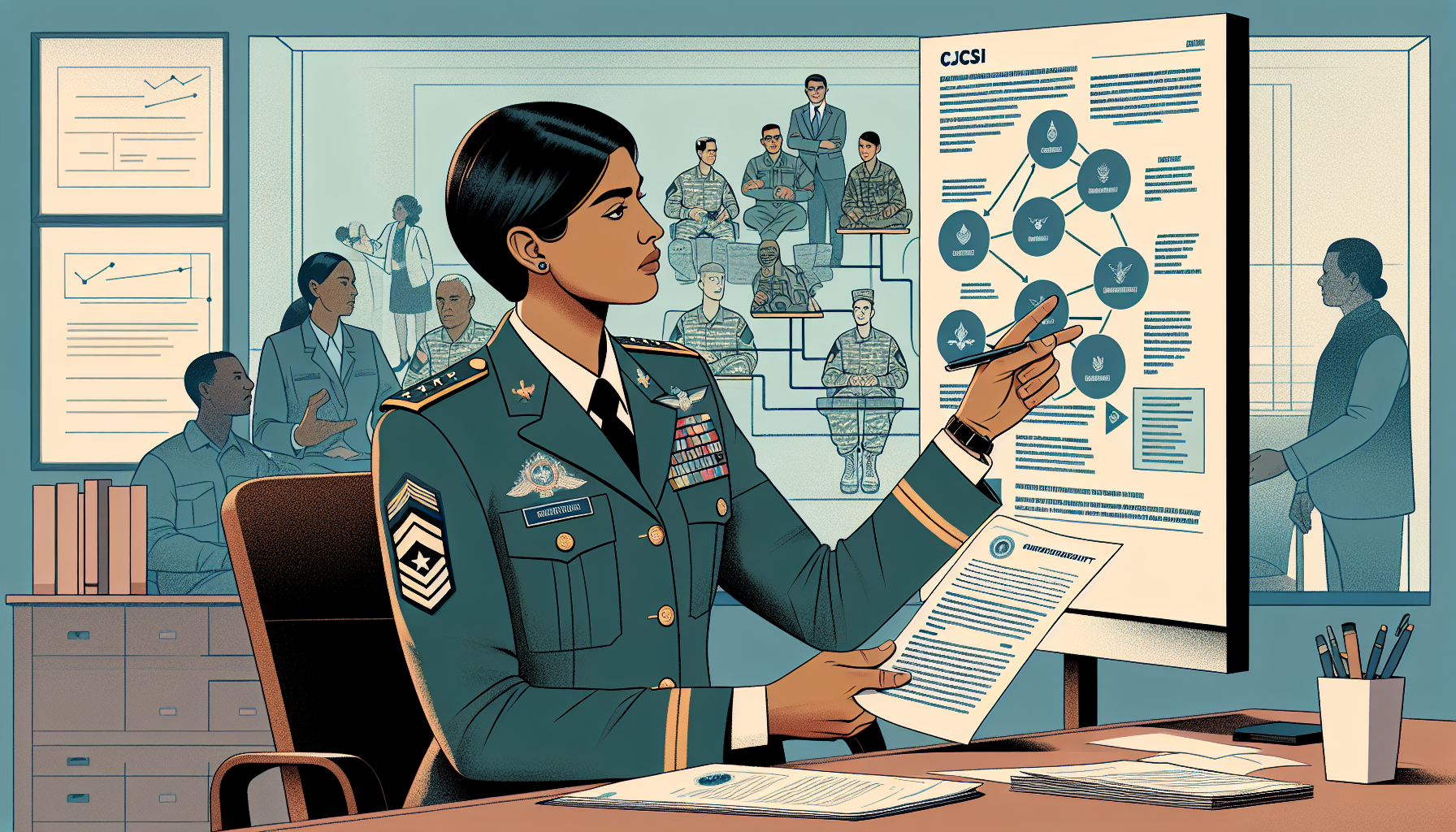Definition
Chairman of the Joint Chiefs of Staff Instruction (CJCSI) refers to a type of directive issued by the Chairman of the Joint Chiefs of Staff (CJCS) to provide guidance and direction for military operations and procedures. These instructions are usually disseminated to the Joint Staff, the Services, and other relevant organizations within the Department of Defense. The goal of CJCSI is to enhance uniformity, consistency, and coordination among the U.S. Armed Forces and streamline their functions.
Key Takeaways
- The Chairman of the Joint Chiefs of Staff Instruction (CJCSI) is a key directive issued by the chairman to provide guidance, policy, and direction to the Joint Chiefs of Staff, combatant commands, and other Department of Defense components.
- CJSCIs cover a wide range of topics such as organization, training, operations, and personnel, as well as standardization and interoperability of equipment and procedures for U.S. military forces.
- As the highest-ranking military officer in the Department of Defense, the Chairman of the Joint Chiefs of Staff has the authority to issue CJSCIs to ensure the effective planning, execution, and management of joint military operations and resources.
Importance
The Chairman of the Joint Chiefs of Staff Instruction (CJCSI) is an important term in military operations as it refers to a series of formal guidance documents issued by the Chairman of the Joint Chiefs of Staff (CJCS), the highest-ranking military officer in the United States Armed Forces.
These instructions are crucial in providing direction, establishing policies, and articulating procedures to various stakeholders, including the Joint Staff, the Combatant Commands, and other Department of Defense components.
The CJCSI plays an essential role in ensuring the coordination, standardization, and effectiveness of the military’s operational readiness and capabilities, thus contributing to the overall national security and defense strategy of the United States.
Explanation
The Chairman of the Joint Chiefs of Staff Instruction (CJCSI) serves to provide critical guidance and direction within the United States Department of Defense (DoD). Its primary purpose is to coordinate and establish joint military policies, procedures, and doctrine, which ultimately contribute to the effective functioning of the defense forces. As a key element in maintaining the synergy of the U.S.
military and streamlining its actions, the CJCSI acts as a vital tool, authored and disseminated by the highest-ranking military officer, the Chairman of the Joint Chiefs of Staff. This guidance helps in unifying the diverse branches of the military, including the Army, Navy, Air Force, and Marine Corps, ensuring that they operate as a cohesive and potent force during both peace and war.
Moreover, the CJCSI facilitates the creation of standardized joint tactics, techniques, and procedures for use in joint operations, integrating the individual capabilities of each armed service. As such, it is essential in fostering harmonious decision-making, responsive command and control, and cooperative execution of national security objectives across all branches.
These instructions span a wide range of topics, including but not limited to joint training, capabilities development, communications systems, and personnel management. In essence, the Chairman of the Joint Chiefs of Staff Instructions significantly contribute to the seamless interoperability, preparedness, and adaptability of the United States military forces, ensuring their unwavering capacity to defend the nation and its interests.
Examples of Chairman of the Joint Chiefs of Staff instruction (CJCSI)
CJCSI01B – Standing Rules of Engagement (SROE) for U.S. Forces: The instruction, published in June 2005, provides a set of standard rules governing the use of force by U.S. military personnel during their operations. The document offers guidelines to commanders on how their troops should respond to various threats, protecting themselves, and ensuring mission success. It establishes a framework for the right of self-defense, rules on the use of force, and helps maintain consistency in the way U.S. troops carry out operations.
CJCSI01B – Joint Training Policy for the Armed Forces of the United States: This instruction, released in April 2008, establishes a framework for joint military training and readiness in the U.S. Armed Forces. The policy outlines the necessary steps taken to ensure that military personnel receive the adequate, rigorous, and up-to-date training needed for their respective roles. The document covers topics such as joint training systems, objectives, standards, program management, and evaluation processes, and is aimed at advancing joint mission readiness.
CJCSI01A – Global Force Management Allocation Plan: This instruction, published in May 2013, provides guidance for deploying and allocating U.S. forces around the world in support of strategic goals and objectives. The purpose of the plan is to optimize the use of available military resources, ensuring that forces are appropriately positioned and equipped to deal with threats that may emerge. The instruction contains information regarding the allocation of forces, mission sets, potential troop rotations, and coordination among the combatant commanders and military departments.
FAQ Section: Chairman of the Joint Chiefs of Staff Instruction (CJCSI)
What is the Chairman of the Joint Chiefs of Staff Instruction (CJCSI)?
The Chairman of the Joint Chiefs of Staff Instruction (CJCSI) is a series of official documents containing direction, policy, and guidance issued by the Chairman of the Joint Chiefs of Staff (CJCS) for the U.S. military’s joint training, doctrine, and policy matters. These instructions are used to govern the activities of the Joint Staff and provide guidance to combatant commanders and other elements within the Department of Defense (DoD).
Who is the intended audience for the CJCSI?
The intended audience for the CJCSI includes personnel from all branches of the U.S. armed forces, the Joint Staff, combatant commands, the National Guard Bureau, and the Office of the Secretary of Defense. The guidance and policies within these instructions are intended to facilitate coordination, communication, and collaboration among these entities.
What is the purpose and importance of CJCSI?
The purpose of the CJCSI is to ensure efficiency, effectiveness, and standardization within the joint military environment. By outlining guidance and policy, the CJCSI helps to improve communication and decision-making among the various stakeholders involved in joint military operations. This ultimately contributes to the overall mission success and national security objectives of the United States.
How often are CJCSIs revised and updated?
CJCSIs are revised and updated on a regular basis to ensure that they stay current with changes in the strategic environment, military technology, and DoD policy. The frequency of updates may vary depending on the document, but revisions typically occur at least once every three to five years or as needed in response to shifting priorities and emerging challenges.
Where can I find a comprehensive list of CJCSIs?
A comprehensive list of CJCSIs can be found on the official website of the Joint Chiefs of Staff. The website contains an online library that provides access to current and archived CJCSIs, along with other policy documents relevant to the U.S. military. Access to some of these documents may be limited due to classification levels and other restrictions.
Related Military Operation Terms
- Joint Military Education
- Force Readiness Training
- Unified Combatant Commands
- Interagency Coordination
- National Security Strategy
Sources for More Information
- Joint Chiefs of Staff Official Website
- U.S. Department of Defense Official Website
- Homeland Security Digital Library
- USA.gov
 Benefits.com Advisors
Benefits.com Advisors
With expertise spanning local, state, and federal benefit programs, our team is dedicated to guiding individuals towards the perfect program tailored to their unique circumstances.
Rise to the top with Peak Benefits!
Join our Peak Benefits Newsletter for the latest news, resources, and offers on all things government benefits.




















